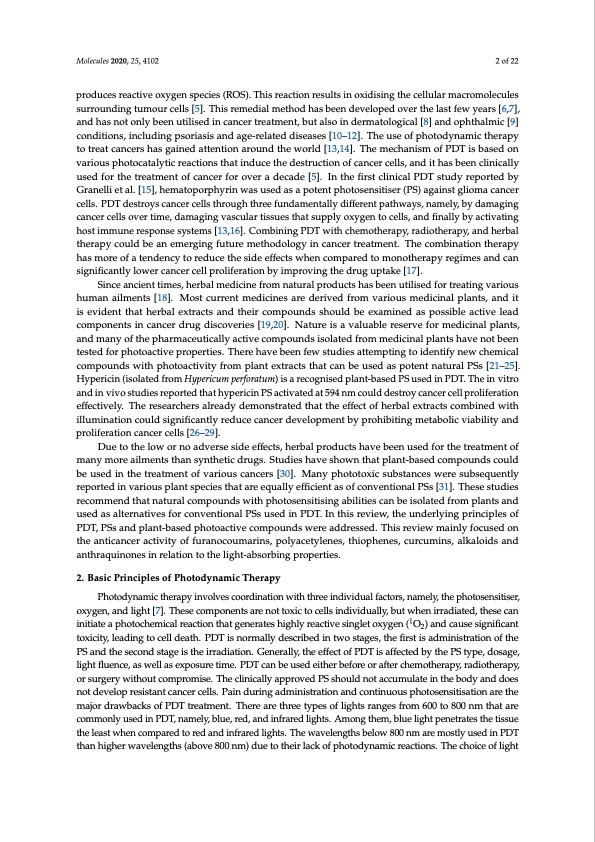
PDF Publication Title:
Text from PDF Page: 002
Molecules 2020, 25, 4102 2 of 22 produces reactive oxygen species (ROS). This reaction results in oxidising the cellular macromolecules surrounding tumour cells [5]. This remedial method has been developed over the last few years [6,7], and has not only been utilised in cancer treatment, but also in dermatological [8] and ophthalmic [9] conditions, including psoriasis and age-related diseases [10–12]. The use of photodynamic therapy to treat cancers has gained attention around the world [13,14]. The mechanism of PDT is based on various photocatalytic reactions that induce the destruction of cancer cells, and it has been clinically used for the treatment of cancer for over a decade [5]. In the first clinical PDT study reported by Granelli et al. [15], hematoporphyrin was used as a potent photosensitiser (PS) against glioma cancer cells. PDT destroys cancer cells through three fundamentally different pathways, namely, by damaging cancer cells over time, damaging vascular tissues that supply oxygen to cells, and finally by activating host immune response systems [13,16]. Combining PDT with chemotherapy, radiotherapy, and herbal therapy could be an emerging future methodology in cancer treatment. The combination therapy has more of a tendency to reduce the side effects when compared to monotherapy regimes and can significantly lower cancer cell proliferation by improving the drug uptake [17]. Since ancient times, herbal medicine from natural products has been utilised for treating various human ailments [18]. Most current medicines are derived from various medicinal plants, and it is evident that herbal extracts and their compounds should be examined as possible active lead components in cancer drug discoveries [19,20]. Nature is a valuable reserve for medicinal plants, and many of the pharmaceutically active compounds isolated from medicinal plants have not been tested for photoactive properties. There have been few studies attempting to identify new chemical compounds with photoactivity from plant extracts that can be used as potent natural PSs [21–25]. Hypericin (isolated from Hypericum perforatum) is a recognised plant-based PS used in PDT. The in vitro and in vivo studies reported that hypericin PS activated at 594 nm could destroy cancer cell proliferation effectively. The researchers already demonstrated that the effect of herbal extracts combined with illumination could significantly reduce cancer development by prohibiting metabolic viability and proliferation cancer cells [26–29]. Due to the low or no adverse side effects, herbal products have been used for the treatment of many more ailments than synthetic drugs. Studies have shown that plant-based compounds could be used in the treatment of various cancers [30]. Many phototoxic substances were subsequently reported in various plant species that are equally efficient as of conventional PSs [31]. These studies recommend that natural compounds with photosensitising abilities can be isolated from plants and used as alternatives for conventional PSs used in PDT. In this review, the underlying principles of PDT, PSs and plant-based photoactive compounds were addressed. This review mainly focused on the anticancer activity of furanocoumarins, polyacetylenes, thiophenes, curcumins, alkaloids and anthraquinones in relation to the light-absorbing properties. 2. Basic Principles of Photodynamic Therapy Photodynamic therapy involves coordination with three individual factors, namely, the photosensitiser, oxygen, and light [7]. These components are not toxic to cells individually, but when irradiated, these can initiate a photochemical reaction that generates highly reactive singlet oxygen (1O2) and cause significant toxicity, leading to cell death. PDT is normally described in two stages, the first is administration of the PS and the second stage is the irradiation. Generally, the effect of PDT is affected by the PS type, dosage, light fluence, as well as exposure time. PDT can be used either before or after chemotherapy, radiotherapy, or surgery without compromise. The clinically approved PS should not accumulate in the body and does not develop resistant cancer cells. Pain during administration and continuous photosensitisation are the major drawbacks of PDT treatment. There are three types of lights ranges from 600 to 800 nm that are commonly used in PDT, namely, blue, red, and infrared lights. Among them, blue light penetrates the tissue the least when compared to red and infrared lights. The wavelengths below 800 nm are mostly used in PDT than higher wavelengths (above 800 nm) due to their lack of photodynamic reactions. The choice of lightPDF Image | Role of Photoactive Phytocompounds in Photodynamic Therapy of Cancer

PDF Search Title:
Role of Photoactive Phytocompounds in Photodynamic Therapy of CancerOriginal File Name Searched:
molecules-25-04102.pdfDIY PDF Search: Google It | Yahoo | Bing
Cruise Ship Reviews | Luxury Resort | Jet | Yacht | and Travel Tech More Info
Cruising Review Topics and Articles More Info
Software based on Filemaker for the travel industry More Info
The Burgenstock Resort: Reviews on CruisingReview website... More Info
Resort Reviews: World Class resorts... More Info
The Riffelalp Resort: Reviews on CruisingReview website... More Info
| CONTACT TEL: 608-238-6001 Email: greg@cruisingreview.com | RSS | AMP |